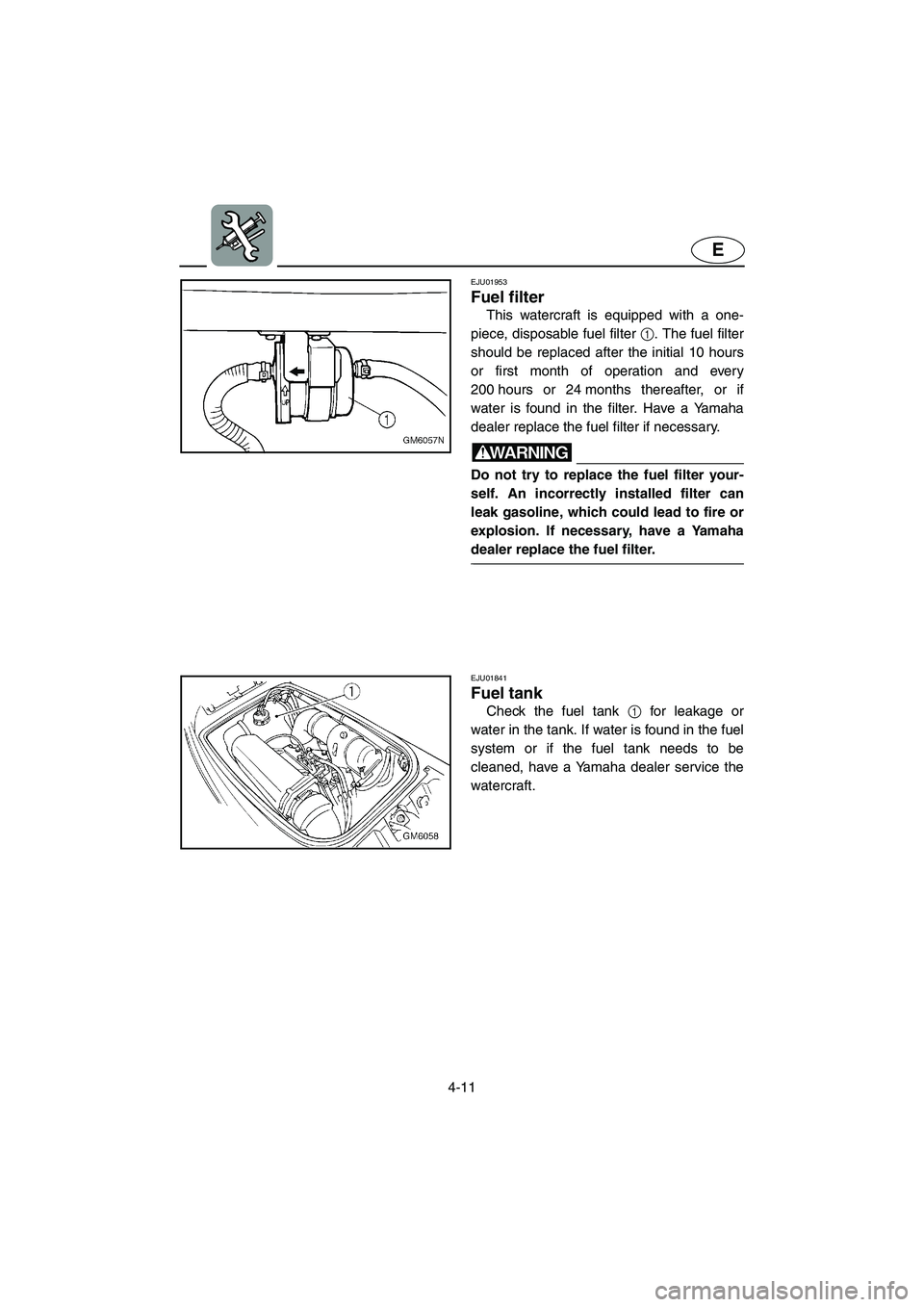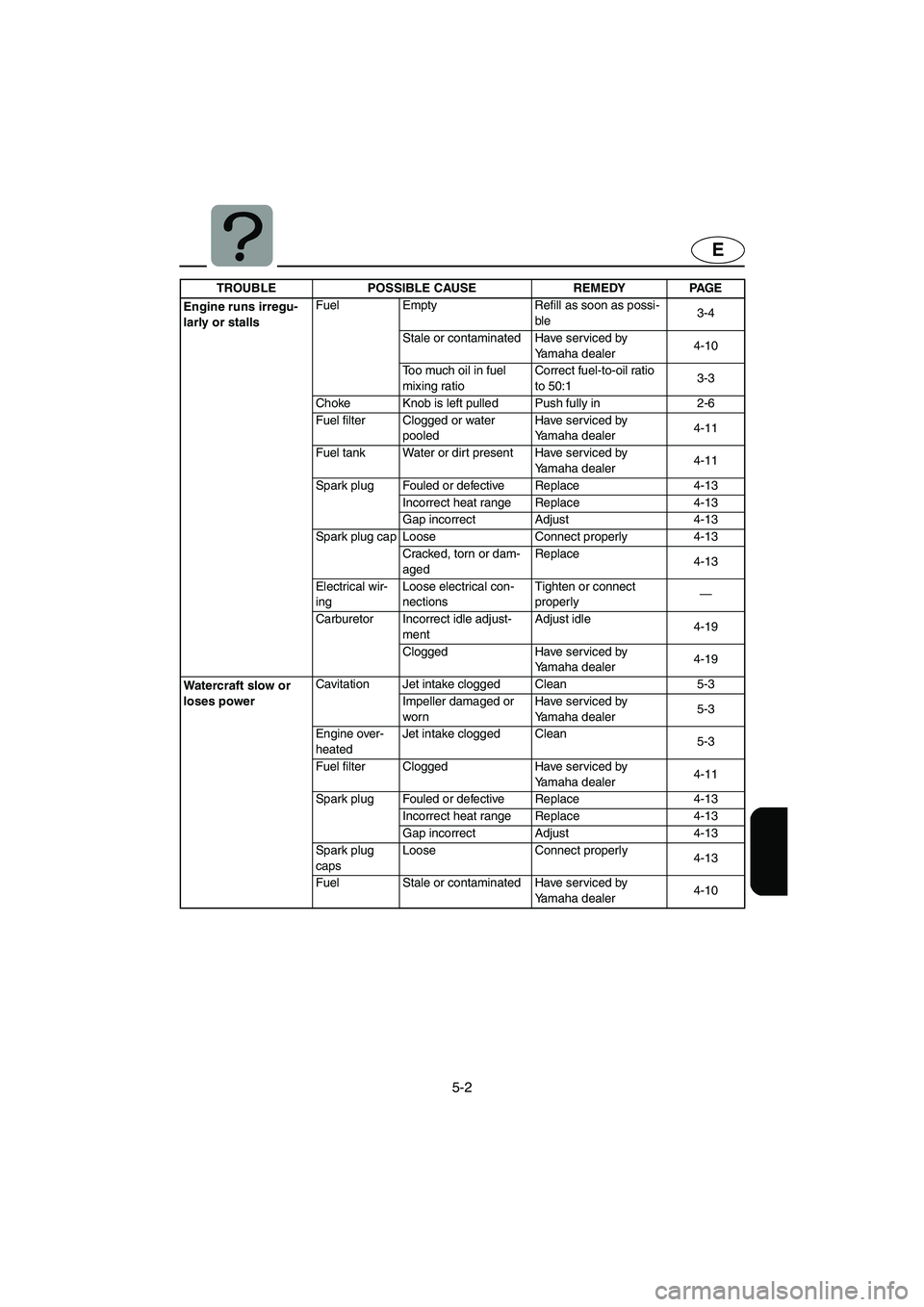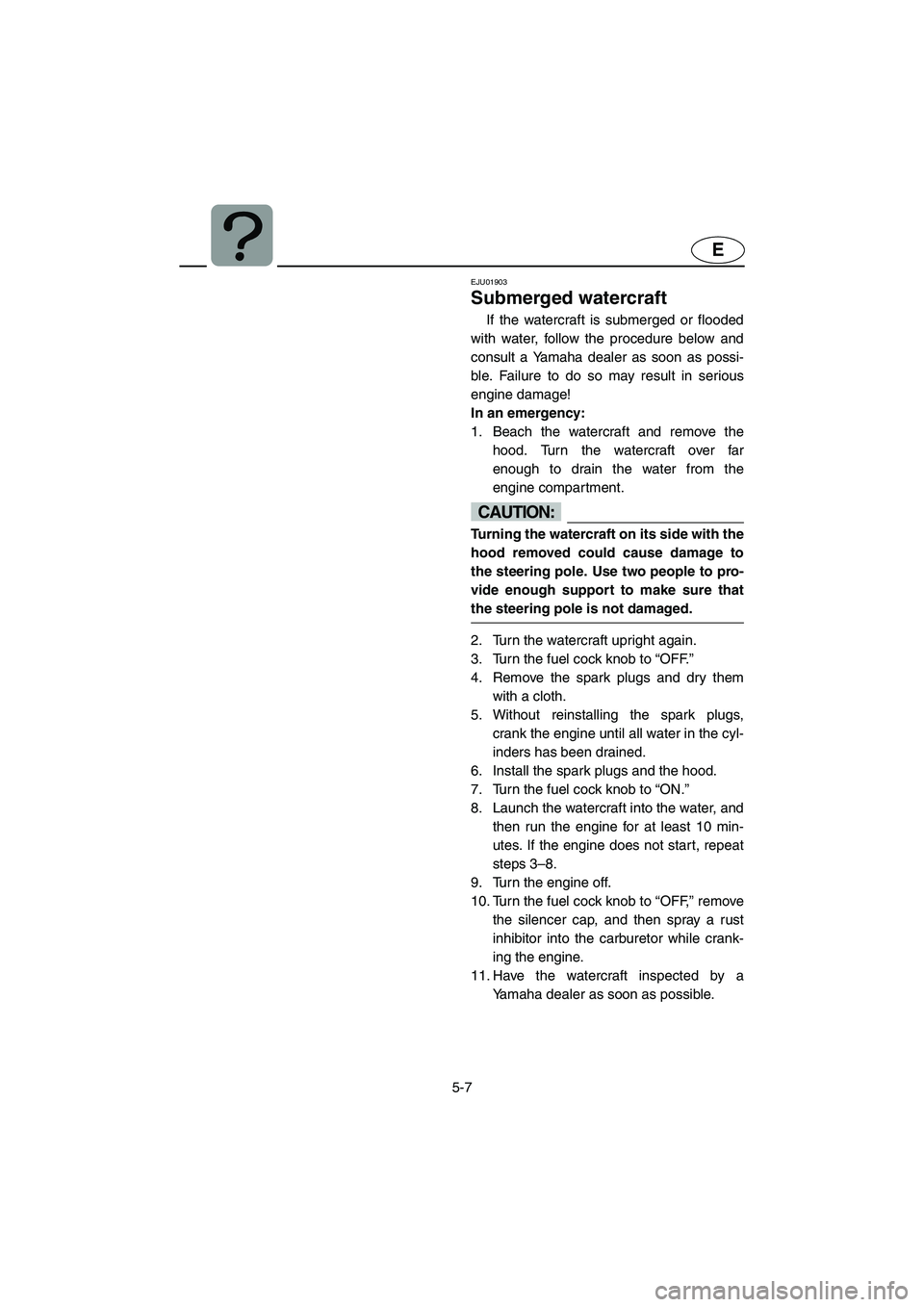2003 YAMAHA SUPERJET fuel
[x] Cancel search: fuelPage 78 of 104

4-11
E
EJU01953
Fuel filter
This watercraft is equipped with a one-
piece, disposable fuel filter 1. The fuel filter
should be replaced after the initial 10 hours
or first month of operation and every
200 hours or 24 months thereafter, or if
water is found in the filter. Have a Yamaha
dealer replace the fuel filter if necessary.
WARNING@ Do not try to replace the fuel filter your-
self. An incorrectly installed filter can
leak gasoline, which could lead to fire or
explosion. If necessary, have a Yamaha
dealer replace the fuel filter.
@
EJU01841
Fuel tank
Check the fuel tank 1 for leakage or
water in the tank. If water is found in the fuel
system or if the fuel tank needs to be
cleaned, have a Yamaha dealer service the
watercraft.
UF1N71.book Page 11 Tuesday, June 4, 2002 3:34 PM
Page 90 of 104

4-23
E
EJU01359
Specifications
*1: Pump Octane Number
*2: Research Octane NumberMODEL
ITEMUnit SJ700
WATERCRAFT CAPACITY
Maximum people on board Number of people 1
DIMENSIONS
Length mm (in) 2,240 (88.2)
Width mm (in) 680 (26.8)
Height mm (in) 660 (26.0)
Dry weight kg (lb) 132 (291)
PERFORMANCE
Maximum power output kW (PS) @ r/min 53.7 (72) @ 6,300
Maximum fuel consumption L/h (US gal/h, Imp gal/h) 29 (7.7, 6.4)
Cruising range at full throttle hr. 0.6
Trolling speed r/min 1,250–1,350
ENGINE
Engine type 2-stroke
Number of cylinders 2
Engine displacement
cm
3 (cu in)701 (42.78)
Bore & stroke mm (in) 81 ×
68 (3.19 ×
2.68)
Compression ratio 7.2
Lubrication system Pre-mixed fuel
Cooling system Water cooled
Starting system Electric starter
Ignition system CDI
Spark plug BR7HS (NGK)
Spark plug gap mm (in) 0.6–0.7 (0.024–0.028)
Battery capacity V-AH 12-19
Charging system Flywheel magneto
DRIVE UNIT
Propulsion system Jet pump
Jet pump type Axial flow, single stage
Impeller rotation Counterclockwise (viewed from rear)
Transmission Direct drive from engine
Jet thrust nozzle angle Degree 37, 41, 45, 49
FUEL AND OIL
Recommended fuel Regular unleaded gasoline
Minimum octane rating PON (*1)
RON (*2)86
90
Recommended engine oil YAMALUBE 2-W, or an equivalent NMMA-
certified TC-W3 marine oil
Fuel mixing ratio (fuel to oil) 50:1
Fuel tank capacity
Total L (US gal, Imp gal) 18 (4.8, 4.0)
Reserve L (US gal, Imp gal) 5.5 (1.45, 1.21)
UF1N71.book Page 23 Tuesday, June 4, 2002 3:34 PM
Page 92 of 104

5-1
E
EJU01116
Troubleshooting
If you have any trouble with your watercraft, use this section to check for the possible
cause.
If you cannot find the cause, or if the procedure for replacement or repair is not described
in this Owner’s/Operator’s Manual, have a Yamaha dealer perform the necessary service.
EJU01367
Troubleshooting chart
TROUBLE POSSIBLE CAUSE REMEDY PAGE
Engine does not
startStarter motor does not turn over
Engine shut-
off switch Clip not in place Install clip
2-5
Fuse Burned out Replace fuse and check
wiring4-20
Battery Run down Recharge 4-17
Poor terminal connec-
tionsTighten as required
4-17
Starter motor Faulty Have serviced by
Yamaha dealer—
Starter motor turns over
Fuel cock Turned to “OFF”Turn fuel cock knob to
“ON”2-4
Fuel Empty Refill as soon as possi-
ble3-4
Stale or contaminated Have serviced by
Yamaha dealer4-10
Fuel tank Water or dirt present Have serviced by
Yamaha dealer4-11
Spark plug Fouled or defective Clean or replace 4-13
Spark plug cap Not connected or loose Connect properly 4-13
Crankcase Filled with water Crank engine with plug
out until clean5-7
Fuel filter Clogged or water
pooledHave serviced by
Yamaha dealer4-11
Choke Knob moves back on
its ownTighten choke knob
adjusting nut4-16
UF1N71.book Page 1 Tuesday, June 4, 2002 3:34 PM
Page 93 of 104

5-2
E
Engine runs irregu-
larly or stallsFuel Empty Refill as soon as possi-
ble3-4
Stale or contaminated Have serviced by
Yamaha dealer4-10
Too much oil in fuel
mixing ratioCorrect fuel-to-oil ratio
to 50:13-3
Choke Knob is left pulled Push fully in 2-6
Fuel filter Clogged or water
pooledHave serviced by
Yamaha dealer4-11
Fuel tank Water or dirt present Have serviced by
Yamaha dealer4-11
Spark plug Fouled or defective Replace 4-13
Incorrect heat range Replace 4-13
Gap incorrect Adjust 4-13
Spark plug cap Loose Connect properly 4-13
Cracked, torn or dam-
agedReplace
4-13
Electrical wir-
ingLoose electrical con-
nectionsTighten or connect
properly—
Carburetor Incorrect idle adjust-
mentAdjust idle
4-19
Clogged Have serviced by
Yamaha dealer4-19
Wate rcr af t slow or
loses powerCavitation Jet intake clogged Clean 5-3
Impeller damaged or
wornHave serviced by
Yamaha dealer5-3
Engine over-
heatedJet intake clogged Clean
5-3
Fuel filter Clogged Have serviced by
Yamaha dealer4-11
Spark plug Fouled or defective Replace 4-13
Incorrect heat range Replace 4-13
Gap incorrect Adjust 4-13
Spark plug
capsLoose Connect properly
4-13
Fuel Stale or contaminated Have serviced by
Yamaha dealer4-10 TROUBLE POSSIBLE CAUSE REMEDY PAGE
UF1N71.book Page 2 Tuesday, June 4, 2002 3:34 PM
Page 98 of 104

5-7
E
EJU01903
Submerged watercraft
If the watercraft is submerged or flooded
with water, follow the procedure below and
consult a Yamaha dealer as soon as possi-
ble. Failure to do so may result in serious
engine damage!
In an emergency:
1. Beach the watercraft and remove the
hood. Turn the watercraft over far
enough to drain the water from the
engine compartment.
CAUTION:@ Turning the watercraft on its side with the
hood removed could cause damage to
the steering pole. Use two people to pro-
vide enough support to make sure that
the steering pole is not damaged.
@
2. Turn the watercraft upright again.
3. Turn the fuel cock knob to “OFF.”
4. Remove the spark plugs and dry them
with a cloth.
5. Without reinstalling the spark plugs,
crank the engine until all water in the cyl-
inders has been drained.
6. Install the spark plugs and the hood.
7. Turn the fuel cock knob to “ON.”
8. Launch the watercraft into the water, and
then run the engine for at least 10 min-
utes. If the engine does not start, repeat
steps 3–8.
9. Turn the engine off.
10. Turn the fuel cock knob to “OFF,” remove
the silencer cap, and then spray a rust
inhibitor into the carburetor while crank-
ing the engine.
11. Have the watercraft inspected by a
Yamaha dealer as soon as possible.
UF1N71.book Page 7 Tuesday, June 4, 2002 3:34 PM
Page 100 of 104

6-1
E
EJU01125
Index
2-stroke engine oil ................................... 3-2
A
Adjusting the carburetor ........................ 4-19
Adjusting the choke cable ..................... 4-16
Adjusting the jet thrust nozzle angle ..... 4-21
Adjusting the steering friction ................ 4-20
Adjusting the trolling speed ................... 4-19
B
Battery .............................................. 3-8, 4-5
Beaching the watercraft ........................ 3-30
Bilge ........................................................ 3-7
Boarding and starting in deep water ..... 3-22
Boarding and starting in shallow
water ..................................................... 3-24
C
Capsized watercraft .............................. 3-26
Choke knob ............................................. 2-6
Cleaning and adjusting the spark
plugs...................................................... 4-13
Cleaning the jet intake and impeller ........ 5-3
Cleaning the watercraft ........................... 4-6
Connecting the jumper cables................. 5-5
Cooling water pilot outlet ................ 2-7, 3-12
Cruising limitations .................................. 1-7
E
Emergency procedures ........................... 5-3
Engine break-in ..................................... 3-13
Engine compartment ............................... 3-6
Engine overheat warning system ............ 2-9
Engine serial number .............................. 1-1
Engine shut-off cord (lanyard) ............... 3-11
Engine shut-off switch ............................. 2-5
Engine stop switch .................................. 2-5
Enjoy your watercraft responsibly ......... 1-13
F
Filling the fuel tank .................................. 3-4
Fire extinguisher...................................... 3-9
Flushing the cooling system .................... 4-1
Fuel and oil.............................................. 3-1
Fuel cock knob ........................................ 2-4Fuel filter ............................................... 4-11
Fuel system ......................................3-6, 4-5
Fuel tank ............................................... 4-11
Fuel tank filler cap ................................... 2-4
G
Gasohol ................................................... 3-2
Gasoline .................................................. 3-1
Getting to know your watercraft ............ 3-19
H
Hazard information ................................ 1-11
Hood........................................................ 2-3
Hull Identification Number (HIN).............. 1-1
I
Identification numbers ............................. 1-1
Important labels ....................................... 1-2
Inspecting and adjusting the throttle
cable...................................................... 4-12
Inspecting the battery ............................ 4-17
Inspecting the fuel system ..................... 4-10
Inspecting the jet thrust nozzle angle .... 4-12
J
Jet unit................................................... 3-11
Jumping the battery ................................. 5-4
K
Kneeling ................................................ 3-25
L
Label location .......................................... 1-2
Learning to operate your watercraft ...... 3-19
Leaving the watercraft ........................... 3-18
Limitations on who may operate the
watercraft ................................................ 1-6
Location of main components ................. 2-1
Lubrication............................................... 4-3
Lubrication points .................................. 4-14
M
Maintenance and adjustments ................ 4-7
Mixing fuel and oil ................................... 3-3
O
Operating positions ............................... 3-25
Operating your watercraft ...................... 3-19
Operation .............................................. 3-13
Operation of controls and other
functions .................................................. 2-3
UF1N71.book Page 1 Tuesday, June 4, 2002 3:34 PM